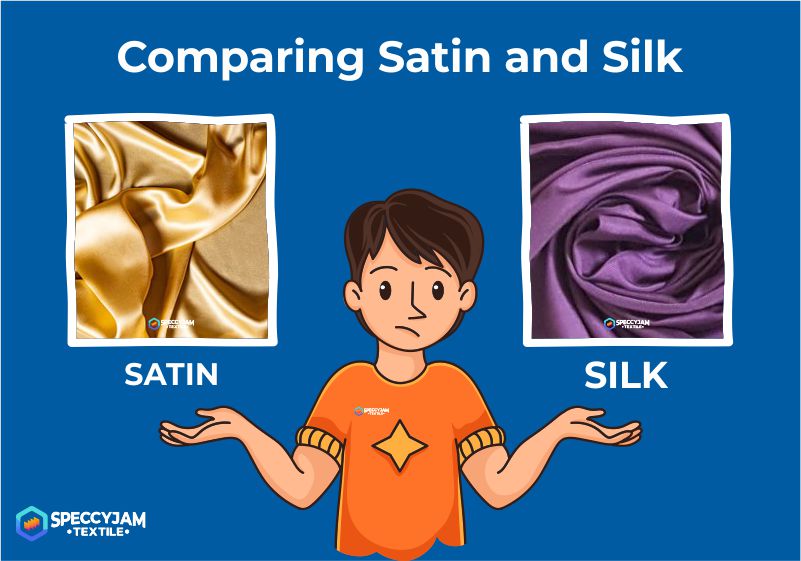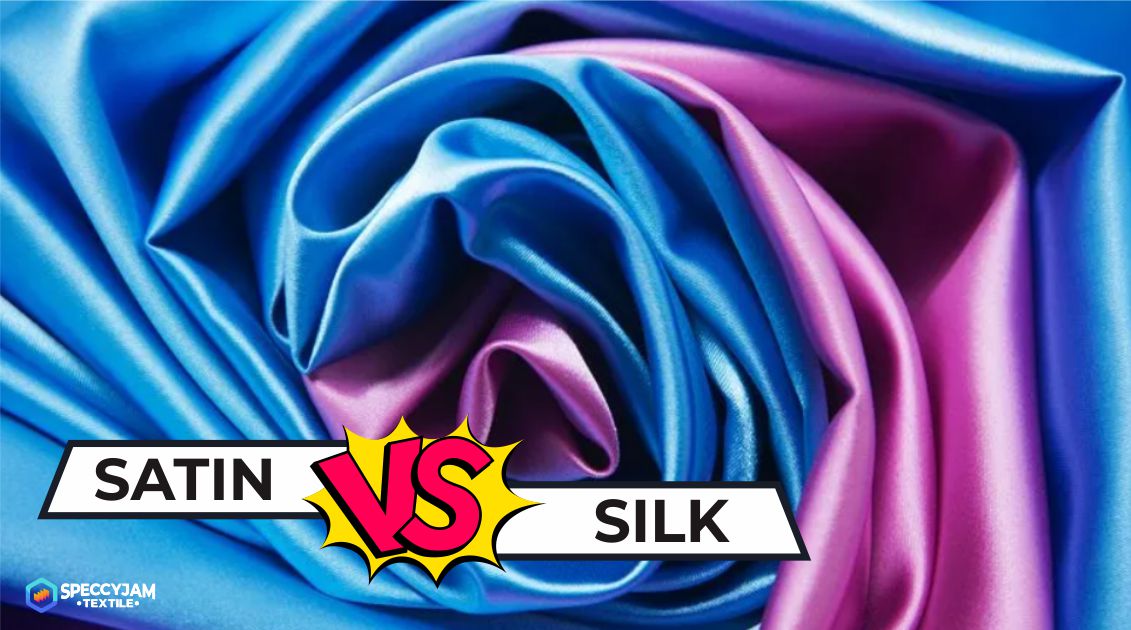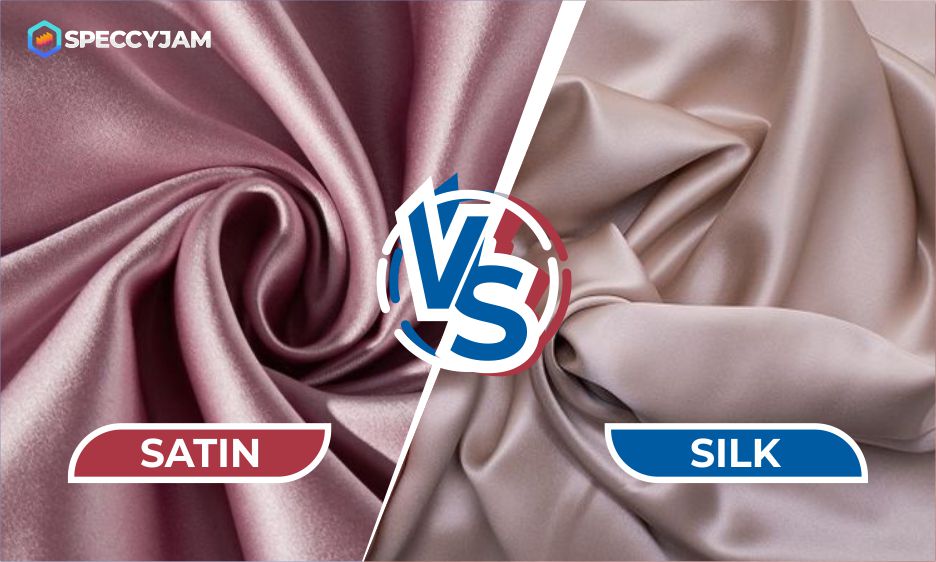By appearances only, people may see very similar fabrics. Both look shiny, and soft and have a luxurious element. Comparing satin vs silk, we have to look deeper.
The biggest difference between satin and silk is in how they were made. Silk was made from natural fibers, from silkworm cocoons. Satin is a weave from synthetic fibers, or some people call it ‘man-made.’ Unlike silk, satin is only shiny on one side.

Contents
Comparing Satin and Silk
To make a comparison of satin vs silk, we should go way back to the origin of these fabrics. How they were made, their similarities and differences, and their pros and cons.
1. The Origin
As mentioned above, the biggest difference comes from the origin of these fabrics. You can call silk ‘made from natural fibers’ and satin ‘man-made’. China, India, Thailand, and Uzbekistan are the largest silk producers.
- Satin is a man-made material. Made up of a mixture of silk, nylon, and polyester. Due to the cost, silk in this mixture is often replaced by synthetic fibers. Satin was developed in China during the middle ages. Unlike silk, satin is only shiny on one side, the back is dull.
- Silk is a natural fabric made from the cocoon of silkworms (mostly mulberry silkworms). Each fiber is unwound from the cocoons, made into threads, to be woven into cloth. Found in China about 12,000 years ago. Both sides are shiny, which made it look more luxurious.
2. The Feel and Its Maintenance
We know by appearance, both look the same. But when you touch and feel each fabric, you’ll instantly feel the difference between satin vs silk.
- Satin is only shiny on one side, and the back is dull, but it feels cool to the touch. It is also more delicate than silk, so it needs more careful handling. Easier to launder, but the best is dry clean it for durability. It can shrink up to 20-40% if washed with hot water.
- Silk is shiny on both sides. Like cotton, silk is also highly absorbent, which can rob hair and skin of their natural oils. Silk can warm up with body heat, not cool as satin. But it’s breathable so it will feel more comfortable. Silk can be easily hand/machine-washed with cold water, so it’ll cost less in maintenance.
3. The Uses
The difference between satin vs silk is also displayed by their uses. Both have several uses but usually, the cost will play as the main consideration.
- Satin can be used as sheets, lingerie, evening wear, wedding dresses, and even hats and ties. The price of satin is probably cheaper than silk, but it needs higher maintenance. So, the types of uses need to consider the dry cleaning method. Avoid using hot water to wash it because it will shrink.
- Silk, on the other hand, has more uses, even though the price is expensive. Besides the types of uses as satin above, silk is also used for parachutes or curtains. It’s easier to clean by hand or by washing machine with cold water. More durable for the long term.
4. The Durability
Each time we want to choose between using satin vs silk, we also have to think about its durability. Because we want to have it as long as possible.
- Satin is not durable. It needs higher maintenance for better durability. Slight friction with a rough surface can cause damage. It also ‘pills’ (makes lint or fuzzball) easily. So even though it’s cool for sleeping materials, it also caused friction that can damage the fabric.
- Silk may be considered a fragile fabric but the fiber it’s made is very strong and durable. Silk can be used to make different weaves. From lightweight and fine woven, to densely woven. The thicker the weave, the fabric will be more durable.
5. The Price
Like any kind of object, the process of making satin vs silk will make the cost. Has been known since the beginning that silk has a higher processing cost which makes it expensive.
- Satin as a man-made fabric can be manufactured in bulk. Especially if it is made from synthetic fibers, the cost can be cheaper. That is why most people used satin in varieties of objects. The price will be slightly higher if it contains silk fibers.
- Silk has undergone a long and detailed process before it becomes fabric. The silkworms, harvesting process, and manufacturing process, all have a high cost. In the end, the price will be expensive. But since it has higher durability and maintenance, it could balance the price.

Pros and Cons
In comparing satin vs silk with the above considerations, we could summarize the main points. These facts will help you choose which one is more suitable for your needs?
1. Pros
As mentioned above, there are many pros to consider in using either one of these fabrics. In the end, it will depend on your purpose. The pros are:
- Satin has a luxuriant texture, and cool feel, and is cheaper than silk. Also resistant to mildew and dust mites.
- Silk also has a luxurious appearance, soft and smooth. Shiny with a subtle rainbow-like hue. It’s breathable and less likely to cause chafing. It’s strong and durable.
2. Cons
After considering the pros, you should also be thinking about the cons. This fact probably will help more in choosing one of them. The cons are:
- Satin can easily be damaged and produced lint balls by friction. Not breathable, unless it was made from silk. Even though it’s cheaper than silk, it needs high maintenance to maintain durability. It could be expensive in the long run.
- Silk also can damage easily when wet. But its durability is preferable for the longer term. The price is expensive, but the maintenance is cheaper.
- One thing is probably a bit disturbing: to harvest the cocoon, the silkworms were killed in most cases (to avoid it bursting out of the cocoon and damaging it).
By comparing satin vs silk we can see a lot of differences between them. Which one to choose will heavily depend on your end purpose. Both look luxurious, but silk is more durable in the long run and easier to maintain.
